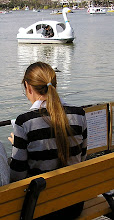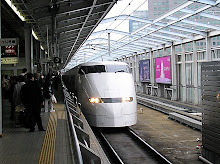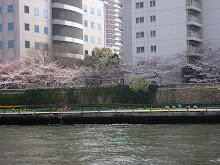 Lake Ashi with spectacular Fuji in the background - image Odakyu Electric Railway
Lake Ashi with spectacular Fuji in the background - image Odakyu Electric RailwayThere are many ways to do the Mt Fuji area. On an earlier trip Julie took an organised tour bus to the 5th station on the mountain, did a short walk on the mountain track, followed by a cruise on nearby Lake Ashi, a cable car ride up Komagatake mountain and then had the choice of an overnight stay in a hot-spring hotel in one of the mountain villages or a return to Tokyo. She took the hotel stay.
I’ve heard the 5 lake trip is popular in the Fuji National Park.
I also read recently that the climb to the summit is one of the more popular and easier treks to a major world peak (easier is maybe a relative term) - apparently many people time their climb to be at the top at daybreak, to beat the usual build-up of cloud. Most of the guide books have outlines on how to best do this.
My visit was a bit less strenuous - a circuit combining normal rail, zig zag rail, cable-rail, cable-car, pirate ship, trekking and bussing through major attractions in the Mount Fuji National Park without actually walking on the mountain itself. There is the opportunity of lots of fantastic views of the nearby mountain if the day has little cloud - which is not all that common.
This circuit is known as the Hakone Course. Julie and I started this at Odawara Station where we jumped off the bullet train after taking advantage of our 7 day JR rail pass for a quick 40 minute trip down from Tokyo. The Odakyu Rail Line office at Odawara station sells passes for all the transport on the circuit - the cheapest is actually a 2 day pass weekdays which in March 08 cost us 3900 yen (about $us38 - $aud40 at the time).
If you haven’t got a JR Rail Pass, you can buy a Hakone Course pass at Shinjuku station in Tokyo which brings you down to the circuit and takes you back to Tokyo for an extra 1100 yen, which is a pretty good deal. You can ride the luxury Romance Car for a small surcharge.
You can check latest prices etc at the Odakyu Electric Railway website. Holders of the pass are also entitled to quite a lot of discounts from businesses and attractions within the circuit.
 The Hakone circuit - starting point Odawara far right. Lake Ashi is bottom left. Mt Fuji is out of frame to the top left - image Odakyu Electric Railways.
The Hakone circuit - starting point Odawara far right. Lake Ashi is bottom left. Mt Fuji is out of frame to the top left - image Odakyu Electric Railways.The first leg was a pretty short normal rail trip along the private Odakyu line from Odawara to Hakone-Yumoto station.
Here we transferred to the zig-zag railway train known as the Hakone Tozan Train. This moves up a picturesque valley on a steep and winding track - at times the train reverses up the next section because the valley is too tight for a normal railway bend. Scenery here is pretty nice - lots of dense forest, views down the steep valley sides to fast flowing streams and post-card villages. If you have just missed Cherry Blossom in Tokyo, the trees may still be in bloom at the higher altitudes along the track.
 The zig-zag Hakone Tozan Train goes thru some very nice countryside - image Odakyu Electric Railway
The zig-zag Hakone Tozan Train goes thru some very nice countryside - image Odakyu Electric RailwayAfter about 40 minutes we reached Gora station where we transferred to the cable-train - a small 2 carriage train pulled up an awesome slope by a steel cable. The slope is so steep the carriages are actually stepped in sections so that the floor and seats are horizontal. Note the Japanese actually call this a cable-car. The trip is not a particularly long, maybe only 2km and goes up through a mountain village with lots of neat houses and a few quite attractive looking hotels. There is an option of walking this leg - I’m pretty fit but after seeing the steepness of the route, I’m glad Julie insisted on the cable-train.
 Hakone-tozan cable train (image Odakyu Electric Railway)
Hakone-tozan cable train (image Odakyu Electric Railway)The cable-train terminates at Sounzan where what the Japanese call a rope-car and I’d call an alpine type cable-car begins its route. The first section to the mountain lookout/restaurant of Owakudani still climbs steeply upwards although the land initially drops away so that you look waaay down to a valley full of steaming thermal pools and vents which have quite a lot of stabilisation activity going on. This is where you will first catch sight of Mt Fuji on the right if it's not too cloudy and you don't keep looking down at the gas-spewing earthworks.


Owakudani is a great rest stop. Nowadays you have to get off the rope-way here as the cars from Sounzan terminate, and you rejoin the ride a few metres on on cars that have come up from the lake. On clear days the view of adjacent Fuji and of the surrounding lower areas is supposed to be awesome. This area was quite crowded largely because the up-mountain road brings a bunch of coaches with enthusiastic domestic tourists, plus quite a few private cars. There is a number of restaurants, cheaper food/drink opportunities and souvenir-type places here.
 There is also a short walk upslope to thermal springs and vents spewing steam and sulphurous fumes into the air. A sign warns that this walk may not be a good idea for asthmatics.
There is also a short walk upslope to thermal springs and vents spewing steam and sulphurous fumes into the air. A sign warns that this walk may not be a good idea for asthmatics. Nevertheless, there were several hundred domestic visitors crowding this area, largely to purchase boiled eggs which are supposed to promote longevity. The eggs are cooked in the thermal springs and have blackened shells because of the fumes. I can report they are pretty okay to eat, even when you don’t find the little bag of salt until the bag is empty. Y500 for a bag of 6 eggs, (including salt).
Nevertheless, there were several hundred domestic visitors crowding this area, largely to purchase boiled eggs which are supposed to promote longevity. The eggs are cooked in the thermal springs and have blackened shells because of the fumes. I can report they are pretty okay to eat, even when you don’t find the little bag of salt until the bag is empty. Y500 for a bag of 6 eggs, (including salt).I initially took the wrong track to try to reach this place and quickly ended up quite a bit higher on a deteriorating path - when I passed a group of hikers heading down-slope I realised I was on one of the hiking tracks that leave from Owakudani - one for you keen trekkers maybe.

Onwards from Owakudani, the rope-car initially climbs higher and then starts its downward journey to Lake Ashi, one of several crater lakes in the area. The views of the lake are pretty special from the rope car, as is Fuji on a clear day.
The terminal at Togendai at the northern end of the lake is similar in facilities to Owakudani, but we didn’t linger and headed directly for the down-lake ferry which is in the form of a PIRATE SHIP!! Sounds corny I know, but I thought the whole concept neat. The cruise itself took maybe 20 minutes and is pretty nice because the longish narrow lake is surrounded mainly by steep forested hill and mountain sides. I elected to stay outside on the upper deck to take maximum advantage of the scenery despite the slight drizzle and cold (it is fairly high up here - note it was a warmish sunny Spring day down in Odawara).
 Like Owakudani, there was a good crowd of people in this section. It seemed the coaches we saw up on the mountain were making Ashi and the cruise the next leg for their passengers. Despite the crowd the pirate ship loaded quickly without undue waiting. As ours left dock another was approaching. Remember to keep your pass handy to flash to the attendants at each change of transport.
Like Owakudani, there was a good crowd of people in this section. It seemed the coaches we saw up on the mountain were making Ashi and the cruise the next leg for their passengers. Despite the crowd the pirate ship loaded quickly without undue waiting. As ours left dock another was approaching. Remember to keep your pass handy to flash to the attendants at each change of transport. Arrival in Hakone Machi - pretty washed out looking pirates IMHO
Arrival in Hakone Machi - pretty washed out looking pirates IMHOThere are two stops at the other end of the lake - Hakone Machi and Moto-Hakone. We got off at the first because our map showed a promising lakeside walk around to Moto-Hakone. Both places by the way are neat lakeside tourist towns with the usual restaurants, hotels etc.
The walk met its promise, going mainly thru natural forest and bush-land sometimes at immediate lakeside, other times climbing steeply up to viewpoints over the lake and towards Fuji. The path in parts is actually part of the old Tokaido Highway which was THE main route along eastern Honshu back in the 16th century. There is a Highway museum near the start on the outskirts of Hakone Machi, an old Edo Shogunate (early 1600s) Checkpoint Gate where the shogun’s soldiers would look out for the bad guys and pirated Taiwanese DVDs, an ancient cedar avenue planted in the same era plus a nice viewpoint about half way at the Hakone Detached Palace Garden. Total distances seemed around 4 to 5 km and took us maybe 90 minutes with frequent stops. This walk is good for those who like solitude, with few other tourists.
 Ancient cedar avenue on the lakeside walk (image Panoramio-Masahiko Nagao)
Ancient cedar avenue on the lakeside walk (image Panoramio-Masahiko Nagao)Moto-Hakone seemed a smaller more picturesque version of Hakone Machi with a nice waterfront walk. Lots of guys fishing along here and we noticed those neat Japanese swan pedal-boats for hire which would be a good way to spend some time on a nice day.
We gave the boats a miss and headed on to the Hakone-jinja shrine less than 2 km further around the lakeside. The first gates can be seen in the water at the lake's edge - these lead uphill to the shrine itself in a thickly wooded hillside area. Once again the tourist coaches had converged on the parking area - no surprises, as temples/shrines go this is one of the better ones in a very attractive area and has historical value being over 1200 years old.
 Steps leading up from lakeside gates to the Hakone shrine - the orange lakeside gates can be seen to the right on the opening photograph of this page (image Panoramio-j.adamson)
Steps leading up from lakeside gates to the Hakone shrine - the orange lakeside gates can be seen to the right on the opening photograph of this page (image Panoramio-j.adamson)We walked back to Moto-Hakone for the start of the last leg - the return by bus to Odawara station for the Tokyo bullet, or to Hakone-Yumoto station for those catching the train back to Shinjuku.
If you want, you can simply hop back on the pirate ship and retrace your steps via the rope-car, cable-train etc. Or you can take advantage of the second day on your pass by spending overnight at somewhere like the Moto- Hakone Guest House. Or you can use your pass on one of the local buses heading up over the low rim of the crater and down the slopes to Odawara station via Hakone-Yumoto.
You have a choice of buses here - a slow one which winds down one of the narrower mountain roads thru scenic forested countryside and a series of villages with hot spring resorts, and a faster one which does a lot of the route on a mountain express-road. Julie has done the former in the past and says it is a very scenic trip, but it was getting late and so we took the fast option this time. Hur hur hur - roadworks had the traffic banked up some way. No worries - even the multi -stop bullets (called Kodama) run fairly frequently (most bullet trains are express thru services) so we did not have to wait too long for a train. Time lakeside to Odawara is normally about 50 minutes.
Hey, pretty excellent trip. Some lovely country, awesome scenery and neat transport options. And the thing is, because of the weather I didn’t see Fuji itself at all! I was prepared for this - Julie has seen it once briefly in 3 trips into the park and numerous passes in the Tokyo-Nagoya bullet. I reckon all those gorgeous clear pix you see are probably taken in winter when the dry-dry (and super-cold) north-westerlies are coming in from unpolluted Siberia.
Now there is no chance of me ever doing a winter trip, but next time we return I wouldn’t mind taking advantage of the 2 day nature of the cheapest pass and actually staying a night somewhere in the Park, even though I might again not get to see Fuji. The area is that nice.
 Lake Ashi from the lakeside walk to Moto-Hakone. Fuji in background (image Panoramio-Andrew Royle)
Lake Ashi from the lakeside walk to Moto-Hakone. Fuji in background (image Panoramio-Andrew Royle)Position of trip area to Tokyo
Let me take my only appearance on this blog to say how impressed I am with travelling Japan (this was my first visit). The scenery is often great, urban landscapes and lifestyles are interesting, the Japanese are so polite, good service is a must, the transport services are brilliant (clean, good value, on-time, fast), accommodation and food costs are value compared to Australia (so even better on average than Western Europe), everything seems to work, and for you guys - the girls are cute - and for you ladies, very fashion conscious in a non-derivative way.





5 comments:
Thank you for your interesting and detailed blog! Reminded me of my own time in Japan and gave me a lot of ideas for my next trip.
Thank you for your super detailed route. This helps a lot for my first trip to Hakone in March.
Island Peak climbing in Khumbu Himalayan range, the Peak is also
known as Imja Tse and is one of the most popular trekking peak climbing in Nepal. Island Peak is the most sought after trekking destination
because of its challenging geographical conditions. Island Peak trek
climbing offers us enchanting views of Mt, Everest (8848m.), Lhotse
(8516m), Amadablam (6856m.) and numerous others peaks and at the same
time it draws the attention towards monasteries and traditional Sherpa
villages. Such a massive glance of the Himalayan peaks can create a
pleasant wave of contentment.
Manaslu Circuit Trekking | Larky Pass / Itinerary / Cost 2017 - See more at: http://www.nepalguideinfo.com/manaslu-trekking/
Nepal Planet Trek snad Expedition
Thank you very much for sharing the knowledge and information through this article.
Budget Tibet Tour
Mt Kailash Tour
Post a Comment